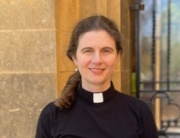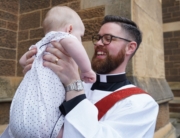Preacher: Dr Baden Teague
Readings: Exodus 15: 1-13, 2nd Samuel 22:1-7, 47-51, Mark 16:1-8.
Prayer: May the words of my lips and the meditations of all our hearts be acceptable to Thee, our strength and our Redeemer.
The Resurrection of Jesus
All of the Hebrew Scriptures and all of the Greek Scriptures increasingly teach about the Resurrection. Death is not the end. There will be a resurrection of the dead. There will be life everlasting.
All four Gospels tell us that Jesus taught his disciples that he would eventually be killed but that he would rise again. But when, on the Easter Sunday, Jesus did rise again, the disciples still needed to be reminded of what the Scriptures said and of what Jesus had said about his own resurrection. They actually experienced Jesus’ life after death. Only then did the promises of God in the Scriptures really make sense to them. Only then did they really believe in the Resurrection.
In our own case we too have all this teaching throughout the Scriptures, and we have the real life Gospel accounts as well. We also have the evidence of how the resurrection of Jesus spurred the growth of the Christian Church eventually to all the world. Out of all this evidence our Service this evening concentrates on just one of the Gospel accounts. Our reading is from the last chapter of Mark.
Chapter 16 of Mark is the story, familiar to many of us, about the dawn of the first Easter Sunday. The women took spice to embalm Jesus’ body where after the Crucifiction a day and a half earlier it had been put in a newly rock-hewn tomb (a ‘cave’, if you like, into the side of a hill, very near Jerusalem). But when they arrived at the tomb, they found the heavy rock-door had been rolled away and the tomb was empty except for the linen grave clothes just lying there. To their surprise there was a messenger who they thought was an angel (and in St John’s account ‘two angels’) and this messenger announced to them, “You are seeking Jesus who was crucified,but he is not here, he is risen.” Naturally, they were astonished and they ran away to tell the men, to tell the eleven disciples, who were still in grief about the Crucifixion. One of the women, Mary Magdalene, however, remained near the tomb and she was the first to witness the resurrected Jesus. Mary saw a person there whom she thought must be the gardener until, in answering her question, Jesus called her by name, “Mary”. She looked up and seeing Jesus, full face, knew that this was Jesus whom she loved, her Lord and her God.
Kathy and I recently visited Jerusalem and just outside the oldest City Wall we went to the site that is most likely the place of Jesus Crucifixion and nearby the burial place that became the place of Jesus Resurrection. For 16 centuries now this area has had built over it an ancient church building called the Church of the Holy Sepulchre. This place is real and it fits the Gospel accounts. In addition, about one kilometre to the East, there is a garden with a hillside that has a rock-hewn tomb, like a cave, that we were able to enter. While inside this tomb I could more easily imagine the kind of burial place that Joseph of Aramathea had provided for Jesus. I could picture in this uncluttered space the details of the Gospel stories: the empty tomb, the grave clothes, the rock doorway rolled away and the messenger who said, “Christ is risen indeed”.
We say together in our Creed every Sunday, “We believe that Jesus, on the third day, rose from the dead.” We also believe that the Resurrection is for all of us, and we believe in the life everlasting.”
Here is our Cathedral on each side of the Transept we have two very large and very beautiful coloured glass windows. They used to be just plain glass. But about 90 years ago this one on the pulpit side was erected. It is all about the Crucifixion of Jesus. Much more recently, about 15 years ago, the window on the lectern side was erected. It is all about the Resurrection of Jesus. Just now you cannot see these two magnificent Windows because it is dark outside, but I urge you one day soon when it is daylight to come up here by the nave table and study them carefully.
The Crucifixion Window, at the top in the centre, has Jesus on the cross. On each side are 4 Old Testament prophets holding across their chests their own texts which prophesy that the Messiah would die to redeem us. Below Jesus, there is John the Baptist saying ‘Behold the Lamb of God’. On each side of John are the four theological fathers of the European Church ( St Jerome, St Gregory, St Ambrose and St Augustine who articulated for us the key message of the Cross). We observe as well that the art of 100 years ago was in a culture about “blokes”; there are only men in this glorious old window.
In great contrast, The Resurrection Window, is about women. It was the women who were the first witnesses of the Resurrection of Jesus. This window has three colourful women on three sides of the empty tomb. Jesus himself is standing on the fourth side completing the circle, not immediately seen but (after we look more carefully) we see Jesus is alive and powerfully present. We call this window the Mary Magdalene window because she too is powerfully present.
This Cathedral community, 15 years ago, wanted to make two big statements by this window. Our first statement is that we believe in the Resurrection of Jesus. Our second statement is that we believe that women are equal with men in the Christian Church. Women can serve now as priests and bishops in our Church and in all leadership positions. We recognise here that it was the women who took the message of the Resurrection to the men disciples. Mary Magdalene and the other women were truly “apostles to the apostles”. Many of us Christians would want to add that we also see women and men as equal in the workplace and equal in our families at home. Sadly, more than half the men in the world, and more than half the men in the Church have still to move forward to accept these principles.
Our Resurrection Window, which is so much about women, also projects a powerful metaphor linking life from the tomb with life from the womb. The colours in the window show a stream of life, of energy, of new creation, springing from the tomb and by metaphor springing from the womb. This stream energises the whole environment with symbols of new life in this stream and eventually everywhere in the window. What an exciting contrast this is then when we see the transformation of the old rather static first window to this new rather dynamic second window.
May I now return to our three Bible Readings this evening. The one from Exodus which the Choir sang as our Psalm is the song of Moses about God’s victory. The one from 2nd Samuel is the song of King David about God’s victory. And the reading from Mark 16 is about the victory of God in the Resurrection of Jesus. Moses and David always looked forward to the hope of this Resurrection victory. In the Gospels the disciples of Jesus recorded the actual experience of that victory.
I believe in the Resurrection of Jesus. By this hope we come to understand the love of God on the Cross. I believe there is a resurrection for everyone of us. This is the gift of God by faith. May we all live our daily lives inspired by the Resurrection in hope, in faith and in love.





